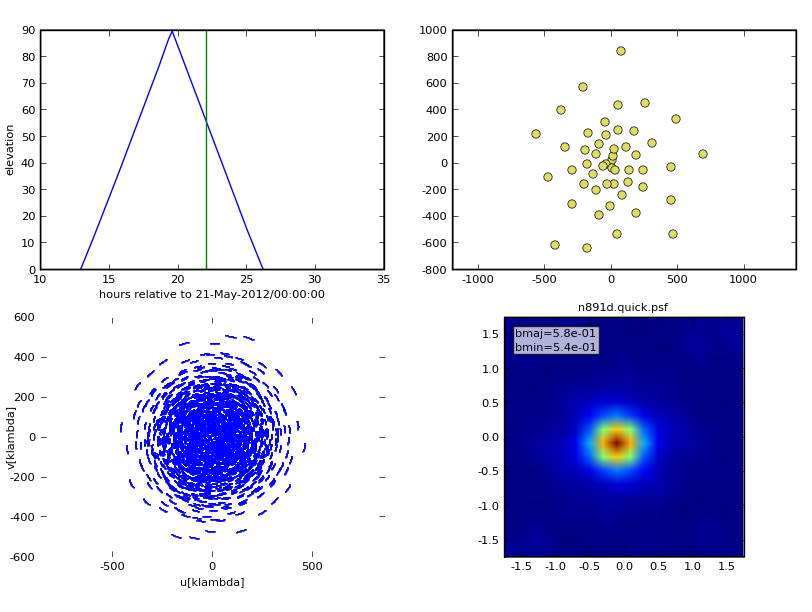Predict: Difference between revisions
Created page with '{{Simulations Intro}} Category: Simulations == Calculating Visibilities == Once you have a sky model with appropriate Coordinate System and a list of pointings, you can cal…' |
|||
| Line 10: | Line 10: | ||
* '''refdate''', '''totaltime''' set when you want to observe and for how long. | * '''refdate''', '''totaltime''' set when you want to observe and for how long. | ||
* <font color="green"><tt>simdata</tt> will recenter the track at transit i.e. the maximum altitude</font>. A long track will see the source rise and set, and placing your model at the appropriate declination can ensure that the source is always low. More flexibility e.g. for snapshot observations through a range of LST, are | * <font color="green"><tt>simdata</tt> will recenter the track at transit i.e. the maximum altitude</font>. A long track will see the source rise and set, and placing your model at the appropriate declination can ensure that the source is always low. More flexibility e.g. for snapshot observations through a range of LST, are currently best achieved by simulating a long track (with image=F if you would like to save time), flagging the timerange near zenith with flagdata, leaving an off-zenith unflagged time range, and then running clean on the ms, either with the clean task, or with simdata (predict=F,noise_thermal="",image=T) | ||
* Mosaic observations will rotate through the mosaic fields during the track defined by '''totaltime''', remaining at each pointing for a duration '''integration'''. No slew time is inserted. | * Mosaic observations will rotate through the mosaic fields during the track defined by '''totaltime''', remaining at each pointing for a duration '''integration'''. No slew time is inserted. | ||
| Line 18: | Line 18: | ||
* If '''sdantlist''' is set, <tt>simdata</tt> will create $project.sd.ms. If '''antennalist''' is set, simdata will (also) create $project.ms. | * If '''sdantlist''' is set, <tt>simdata</tt> will create $project.sd.ms. If '''antennalist''' is set, simdata will (also) create $project.ms. | ||
== Component list == | == Component list == | ||
Revision as of 01:36, 16 June 2011
↵ Simulating Observations in CASA
Calculating Visibilities
Once you have a sky model with appropriate Coordinate System and a list of pointings, you can calculate visibilities. simdata can additionally predict from a Component List named complist (see below).
- antennalist is a text file containing the antenna locations (see Antenna List for details)
- refdate, totaltime set when you want to observe and for how long.
- simdata will recenter the track at transit i.e. the maximum altitude. A long track will see the source rise and set, and placing your model at the appropriate declination can ensure that the source is always low. More flexibility e.g. for snapshot observations through a range of LST, are currently best achieved by simulating a long track (with image=F if you would like to save time), flagging the timerange near zenith with flagdata, leaving an off-zenith unflagged time range, and then running clean on the ms, either with the clean task, or with simdata (predict=F,noise_thermal="",image=T)
- Mosaic observations will rotate through the mosaic fields during the track defined by totaltime, remaining at each pointing for a duration integration. No slew time is inserted.
- One can interleave a calibrator in direction caldirection and flux calflux with one's science pointings. As of CASA 3.0.2, the pointing file should contain the science mosaic, not the calibrator. simdata will observe all pointings of the pointing file, then the calibrator for the same integration time, then the pointings in the pointing file again, etc, until totaltime is used up. Greater flexibility is expected in the future.
- One can additionally or only create a single dish total power observation. Set sdantlist to the file containing the Single Dish antenna location(s). If there is more than one antenna in that file, specify which one to use with sdant.
- If sdantlist is set, simdata will create $project.sd.ms. If antennalist is set, simdata will (also) create $project.ms.
Component list
as of May 2010, simdata2 simulations of componentlist ONLY (not modelimage) may not fully work.
One way to get a component list is to deconvolve an image, and another is to create it by hand using the cl tool:
cl.done()
cl.addcomponent(dir="J2000 18h00m00.03s -42d0m0.0s", flux=1.0, freq='672.0GHz')
cl.rename("star672GHz.cl")
complist = "star672GHz.cl"
here is a little python program File:Makecl py.txt that will change this ascii file File:My list.txt into a componentlist
warning complist has not been as thoroughly tested as images. email rindebet at nrao.edu with questions or observations.
Graphic Output
If you have graphics turned on, you'll see a diagnostic plot like this one:
